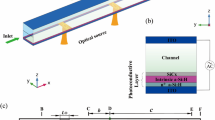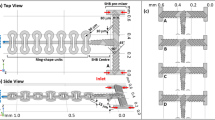Abstract
A new micromixer incorporating integrated electrodes deposited on the bottom surface of a glass/PDMS microchannel is used to induce a localized, perpendicular electric field within pressure driven axial flow. The presence of the electric field drives electro-osmotic flow in the transverse direction along the channel walls, creating helical motion that serves to mix the fluid. A numerical model is used to describe the three-dimensional flow field, where characterization is performed via particle tracking of passive tracer particles, and the conditional entropy (S lc) is utilized to approximate the extent of mixing along cross-sectional planes. The geometrical parameters and operating conditions of the numerical model are used to fabricate an experimental device, and fluorescence microscopy measurements are used to verify mixing of rhodamine B across the width of the microchannel for a wide range of fluid flow rates. The results demonstrate that under certain operating conditions and selective placement of the electrode gaps along the width of the microchannel, efficient mixing can be achieved within 6 mm of the inlet.









Similar content being viewed by others
Notes
Animations displaying the on/off operation of the mixing procedure can be found at http://navier.engr.colostate.edu/eof/.
Animations of fluorescent microsphere entrapment within the primary recirculation region can be found at http://navier.engr.colostate.edu/eof/.
Abbreviations
- L mix :
-
characteristic length for mixing
- T mix :
-
characteristic time for mixing
- ϕ :
-
externally applied potential
- λ d :
-
debye length
- ε :
-
dielectric constant of the fluid
- ε o :
-
permittivity of vacuum
- ζ :
-
zeta-potential
- \( \ifmmode\expandafter\vec\else\expandafter\vec\fi{E} \) :
-
electric field vector
- p :
-
pressure
- μ :
-
viscosity
- \( \ifmmode\expandafter\vec\else\expandafter\vec\fi{u} \) :
-
linear velocity
- φ :
-
stream function
- l e :
-
axial length of the electrode
- w g :
-
width of the electrode gap
- w c :
-
center position of the electrode gap
- t comp :
-
computational time for particle advection
- t n :
-
average computational time for advection between planes
- S lc :
-
conditional mixing entropy
- p j :
-
probability that a particle is in bin j irrespective of species
- p c,j :
-
probability that a particle is of the type c whose position is in bin j
- δ a :
-
adjusted extent of mixing
- I i :
-
fluorescent intensity at pixel i during active mixing
- I i,o :
-
fluorescent intensity at pixel i if no active mixing occurs
- N :
-
total number of pixels across the width of the micro-channel
- w :
-
width of micro-channel
- h :
-
height of micro-channel
- n :
-
total number of electrode cycles
- F :
-
mixing effectiveness
- M :
-
number of bins used to discretize channel cross-sections
- w b :
-
width of bin
- l i :
-
axial position at the start of the i-th electrode cycle
References
Altas I, Dym J, Gupta MM, Manohar RP (1998) Multigrid solution of automatically generated high-order discretizations for the biharmonic equation. SIAM J Sci Comput 19:1575–1585
Anderson JL (1989) Colloid Transport by Interfacial Forces. Annu Rev Fluid Mech 21:61–99
Bhattacharya S, Datta A, Berg JM, Gangopadhyay S (2005) Studies on surface wettability of poly(dimethyl) siloxane (PDMS) and glass under oxygen-plasma treatment and correlation with bond strength. J Microelectromech Syst 14:590–597
Biddiss E, Erickson D, Li DQ (2004) Heterogeneous surface charge enhanced micromixing for electrokinetic flows. Anal Chem 76:3208–3213
Camesasca M, Manas-Zloczower I, Kaufman M (2005) Entropic characterization of mixing in microchannels. J Micromech Microeng 15:2038–2044
Camesasca M, Kaufman M, Manas-Zloczower I (2006) Quantifying fluid mixing with the Shannon entropy. Macromol Theory Simul 15:595–607
Cha J, Kim J, Ryu SK, Park J, Jeong Y, Park S, Park S, Kim HC, Chun K (2006) A highly efficient 3D micromixer using soft PDMS bonding. J Micromech Microeng 16:1778–1782
Chang CC, Yang RJ (2004) Computational analysis of electrokinetically driven flow mixing in microchannels with patterned blocks. J Micromech Microeng 14:550–558
Chang CC, Yang RJ (2006) A particle tracking method for analyzing chaotic electroosmotic flow mixing in 3D microchannels with patterned charged surfaces. J Micromech Microeng 16:1453–1462
Chang CC, Yang RJ (2007) Electrokinetic mixing in microfluidic systems. Microfluidics Nanofluidics 3:501–525
Chen H, Meiners JC (2004) Topologic mixing on a microfluidic chip. Appl Phys Lett 84:2193–2195
Dodge A, Jullien MC, Lee YK, Niu X, Okkels F, Tabeling P (2004) An example of a chaotic micromixer: the cross-channel micromixer. C R Phys 5:557–563
Gitlin I, Stroock AD, Whitesides GM, Ajdari A (2003) Pumping based on transverse electrokinetic effects. Appl Phys Lett 83:1486–1488
Hunter RJ (1981) Zeta potential in colloid science. Academic Press, New York
Jiang F, Drese KS, Hardt S, Kupper M, Schonfeld F (2004) Helical flows and chaotic mixing in curved micro channels. Aiche J 50:2297–2305
Johnson TJ, Locascio LE (2002) Characterization and optimization of slanted well designs for microfluidic mixing under electroosmotic flow. Lab Chip 2:135–140
Kim DS, Lee SW, Kwon TH, Lee SS (2004) A barrier embedded chaotic micromixer. J Micromech Microeng 14:798–805
Lammertink RGH, Schlautmann S, Besselink GAJ, Schasfoort RBM (2004) Recirculation of nanoliter volumes within microfluidic channels. Anal Chem 76:3018–3022
Lee JN, Park C, Whitesides GM (2003) Solvent compatibility of poly(dimethylsiloxane)-based microfluidic devices. Anal Chem 75:6544–6554
Lee CY, Lee GB, Fu LM, Lee KH, Yang RJ (2004) Electrokinetically driven active micro-mixers utilizing zeta potential variation induced by field effect. J Micromech Microeng 14:1390–1398
Leu TS, Ma FC (2005) Novel EHD-pump driven micro mixers. J Mech 21:137–144
Lin H, Storey BD, Oddy MH, Chen CH, Santiago JG (2004) Instability of electrokinetic microchannel flows with conductivity gradients. Phys Fluids 16:1922–1935
Lin JL, Lee KH, Lee GB (2005) Active mixing inside microchannels utilizing dynamic variation of gradient zeta potentials. Electrophoresis 26:4605–4615
McKnight TE, Culbertson CT, Jacobson SC, Ramsey JM (2001) Electroosmotically induced hydraulic pumping with integrated electrodes on microfluidic devices. Anal Chem 73:4045–4049
Meleshko VV (1998) Biharmonic problem in a rectangle. Appl Sci Res 58:217–249
Munson MS, Yager P (2004) Simple quantitative optical method for monitoring the extent of mixing applied to a novel microfluidic mixer. Analytica Chimica Acta 507:63–71
Neils C, Tyree Z, Finlayson B, Folch A (2004) Combinatorial mixing of microfluidic streams. Lab Chip 4:342–350
Niu XZ, Lee YK (2003) Efficient spatial-temporal chaotic mixing in microchannels. J Micromech Microeng 13:454–462
Niu XZ, Liu LY, Wen WJ and Sheng P (2006) Hybrid approach to high-frequency microfluidic mixing. Phys Rev Lett 97
Oddy MH, Santiago JG, Mikkelsen JC (2001) Electrokinetic instability micromixing. Anal Chem 73:5822–5832
Pacheco JR, Chen KP, Hayes MA (2006) Rapid and efficient mixing in a slip-driven three-dimensional flow in a rectangular channel. Fluid Dyn Res 38:503–521
Park J, Shin SM, Huh KY and Kang IS (2005) Application of electrokinetic instability for enhanced mixing in various micro-T-channel geometries. Phys Fluids 17
Qian SZ, Bau HH (2002) A chaotic electroosmotic stirrer. Anal Chem 74:3616–3625
Qian SZ, Bau HH (2005) Theoretical investigation of electro-osmotic flows and chaotic stirring in rectangular cavities. Appl Math Model 29:726–753
Sato H, Ito S, Tajima K, Orimoto N, Shoji S (2005) PDMS microchannels with slanted grooves embedded in three walls to realize efficient spiral flow. Sens Actuators A Phys 119:365–371
Schonfeld F, Hardt S (2004) Simulation of helical flows in microchannels. Aiche J 50:771–778
Selverov KP, Stone HA (2001) Peristaltically driven channel flows with applications toward micromixing. Physics of Fluids 13:1837–1859
Stone ZB, Stone HA (2005) Imaging and quantifying mixing in a model droplet micromixer. Phys Fluids 17
Stone HA, Stroock AD, Ajdari A (2004) Engineering flows in small devices: Microfluidics toward a lab-on-a-chip. Annu Rev Fluid Mech 36:381–411
Stroock AD, Dertinger SK, Whitesides GM, Ajdari A (2002a) Patterning flows using grooved surfaces. Anal Chem 74:5306–5312
Stroock AD, Dertinger SKW, Ajdari A, Mezic I, Stone HA, Whitesides GM (2002b) Chaotic mixer for microchannels. Science 295:647–651
Sundaram N, Tafti DK (2004) Evaluation of microchamber geometries and surface conditions for electrokinetic driven mixing. Anal Chem 76:3785–3793
Sudarsan AP, Ugaz VM (2006) Fluid mixing in planar spiral microchannels. Lab Chip 6:74–82
Suzuki H, Ho CM, Kasagi N (2004) A chaotic mixer for magnetic bead-based micro cell sorter. J Microelectromech Syst 13:779–790
Sze A, Erickson D, Ren LQ, Li DQ (2003) Zeta-potential measurement using the Smoluchowski equation and the slope of the current-time relationship in electroosmotic flow. J Colloid Interface Sci 261:402–410
Therriault D, White SR, Lewis JA (2003) Chaotic mixing in three-dimensioned microvascular networks fabricated by direct-write assembly (vol 2, pg 265, 2002). Nat Mater 2:347–347
Vickers JA, Caulum MM, Henry CS (2006) Generation of hydrophilic poly(dimethylsiloxane) for high-performance microchip electrophoresis. Anal Chem 78:7446–7452
West J, Gleeson JP, Alderman J, Collins JK, Berney H (2003) Structuring laminar flows using annular magnetohydrodynamic actuation. Sens Actuators B Chem 96:190–199
Wu HY, Liu CH (2005) A novel electrokinetic micromixer. Sens Actuators A Phys 118:107–115
Xia YN, Whitesides GM (1998) Soft lithography. Annu Rev Mater Sci 28:153–184
Yamaguchi Y, Takagi F, Watari T, Yamashita K, Nakamura H, Shimizu H, Maeda H (2004a) Interface configuration of the two layered laminar flow in a curved microchannel. Chem Eng J 101:367–372
Yamaguchi Y, Takagi F, Yamashita K, Nakamura H, Maeda H, Sotowa K, Kusakabe K, Yamasaki Y, Morooka S (2004b) 3-D simulation and visualization of laminar flow in a microchannel with hair-pin curves. Aiche J 50:1530–1535
Yang JT, Huang KJ, Lin YC (2005) Geometric effects on fluid mixing in passive grooved micromixers. Lab Chip 5:1140–1147
Acknowledgments
This work was supported by NIH grant number EB00726.
Author information
Authors and Affiliations
Corresponding author
Rights and permissions
About this article
Cite this article
Lynn, N.S., Henry, C.S. & Dandy, D.S. Microfluidic mixing via transverse electrokinetic effects in a planar microchannel. Microfluid Nanofluid 5, 493–505 (2008). https://doi.org/10.1007/s10404-008-0258-8
Received:
Accepted:
Published:
Issue Date:
DOI: https://doi.org/10.1007/s10404-008-0258-8




